雅思强化阅读
- 格式:ppt
- 大小:938.50 KB
- 文档页数:24
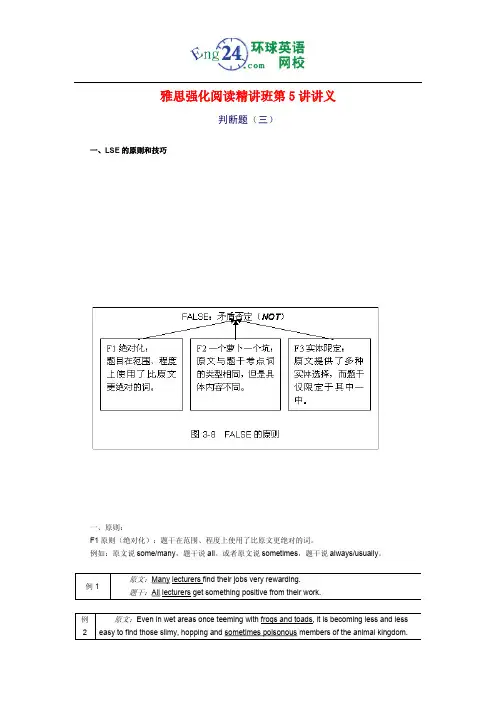
雅思强化阅读精讲班第5讲讲义判断题(三)一、LSE的原则和技巧一、原则:F1原则(绝对化):题干在范围、程度上使用了比原文更绝对的词。
例如:原文说some/many,题干说all。
或者原文说sometimes,题干说always/usually。
例1 原文:Many lecturers find their jobs very rewarding.题干:All lecturers get something positive from their work.例2原文:Even in wet areas once teeming with frogs and toads, it is becoming less and less easy to find those slimy, hopping and sometimes poisonous members of the animal kingdom.另外,请参见《剑桥6》移民类第一套阅读第五题F2原则(一个萝卜一个坑):原文与题干考点词的类型相同,但是具体内容不同。
例题:F2原则的例题包括:《剑桥3》:T2P1Q2,T3P1Q1/Q2,T3P2Q16,T4P2Q22/Q23《剑桥4》:T1P1Q5《剑桥5》:T2P3Q36,T3P2Q20F3原则(实体限定):原文提供了多种实体选择,而题干仅限定于其中一中。
例如:原文说A and/or B ,题干说only A 。
A and B 相当于NOT only A ,所以存在矛盾,选FALSE 。
例题:F3原则的例题:《剑桥4》T3P1Q11二、技巧:FS1技巧(S代表skill):含有绝对范围、程度考点词的题目大多数选FALSE/NO。
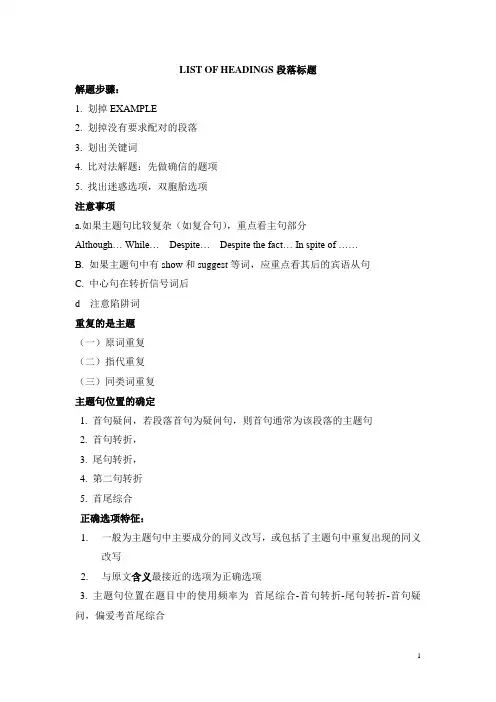
LIST OF HEADINGS段落标题解题步骤:1. 划掉EXAMPLE2. 划掉没有要求配对的段落3. 划出关键词4. 比对法解题:先做确信的题项5. 找出迷惑选项,双胞胎选项注意事项a.如果主题句比较复杂(如复合句),重点看主句部分Although…While…Despite…Despite the fact…In spite of ……B. 如果主题句中有show和suggest等词,应重点看其后的宾语从句C. 中心句在转折信号词后d 注意陷阱词重复的是主题(一)原词重复(二)指代重复(三)同类词重复主题句位置的确定1. 首句疑问,若段落首句为疑问句,则首句通常为该段落的主题句2. 首句转折,3. 尾句转折,4. 第二句转折5. 首尾综合正确选项特征:1.一般为主题句中主要成分的同义改写,或包括了主题句中重复出现的同义改写2.与原文含义最接近的选项为正确选项3. 主题句位置在题目中的使用频率为首尾综合-首句转折-尾句转折-首句疑问,偏爱考首尾综合配对题MATCHING三大题型1. 小标志和长句子配对B类(乱序)人名配观点时间配事件项目-性质属性剑6 TEST 12.长句子和长句子配对A类(正序)问题配答案原因配结果3.段落和长句的配对(段落细节信息题)B类(不按顺序)人物-观点题特征1.题目不按顺序2.题目原文往往和正确答案之间是一种理解关系3.有的人名可以是好几个题目的选项,有的选项可能完全用不上4.第一题往往对应文章靠后的观点解题步骤1. 识别配对的双方的类型以及各自的数量2. 决定先定位哪一方3. 通读配对另一方,划出全部定位词,逐段进行配对阅读所有题干句子-定位人物-阅读原文-引语观点句子-匹配解题- 时间配对题时间的计算Previous, next, later, during, before, after, onwards, simultaneously…注意:1.大多数情况下,每个题目只能选一个选项。
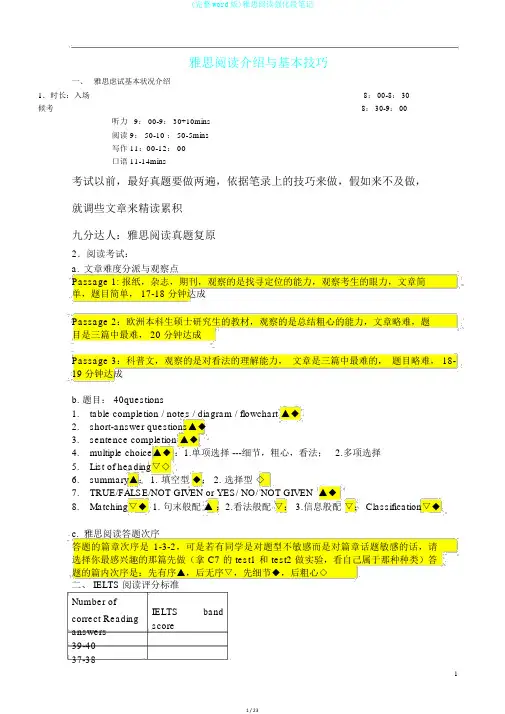
雅思阅读介绍与基本技巧一、雅思虑试基本状况介绍1.时长:入场8: 00-8: 30候考8: 30-9: 00听力9: 00-9: 30+10mins阅读 9: 50-10 : 50-5mins写作 11:00-12: 00口语 11-14mins考试以前,最好真题要做两遍,依据笔录上的技巧来做,假如来不及做,就调些文章来精读累积九分达人:雅思阅读真题复原2.阅读考试:a.文章难度分派与观察点Passage 1: 报纸,杂志,期刊,观察的是找寻定位的能力,观察考生的眼力,文章简单,题目简单, 17-18 分钟达成Passage 2:欧洲本科生硕士研究生的教材,观察的是总结粗心的能力,文章略难,题目是三篇中最难, 20 分钟达成Passage 3:科普文,观察的是对看法的理解能力,文章是三篇中最难的,题目略难, 18-19 分钟达成b. 题目: 40questions1.table completion / notes / diagram / flowchart ▲◆2.short-answer questions▲◆3.sentence completion ▲◆4.multiple choice▲◆:1.单项选择 ---细节,粗心,看法; 2.多项选择5.List of heading▽◇6.summary▲: 1. 填空型◆; 2. 选择型◇7.TRUE/FALSE/NOT GIVEN or YES/ NO/ NOT GIVEN ▲◆8.Matching▽◆ 1. 句末般配▲;2.看法般配▽; 3.信息般配▽; Classification▽◆c.雅思阅读答题次序答题的篇章次序是1-3-2,可是若有同学是对题型不敏感而是对篇章话题敏感的话,请选择你最感兴趣的那篇先做(拿 C7 的 test1 和 test2 做实验,看自己属于那种种类)答题的篇内次序是:先有序▲,后无序▽,先细节◆,后粗心◇二、 IELTS 阅读评分标准Number ofIELTS bandcorrect Readingscoreanswers39-4035-3633-3430-3227-2923-2620-2216-19三、影响考成的因素1.Basic language skillsi)Word study --- stems , affixes, prefixes + context clues guessingii)Sentence study ----a. identify the S. + V. + O. of the sentence.b. What to read(目 ) + how to read(技巧 )填空或许是:什么就找什么的目的是 what/who: n/doing---主,,表的目的是 what do: v---的目的是 how: 介短,状,表的目的是 why: 原由,果,目的 ---状填空的目缺成分就找成分:For example, desert annuls germinate, flower and seed whenever suitable rainfall occurs, regardless of the day length. Regardless adj/adv 否认 Desert annuals respond to rainfall as a signal for reproduction.NA,B and/or C 必定是并列关系,性一致When(ever), what(ever), how(ever), where(ever), who(ever)/whom(ever), that, which, whose 以上些已出,个句子里必定包括一个主句一个从句,也就是必定会有两个或许是合存在。
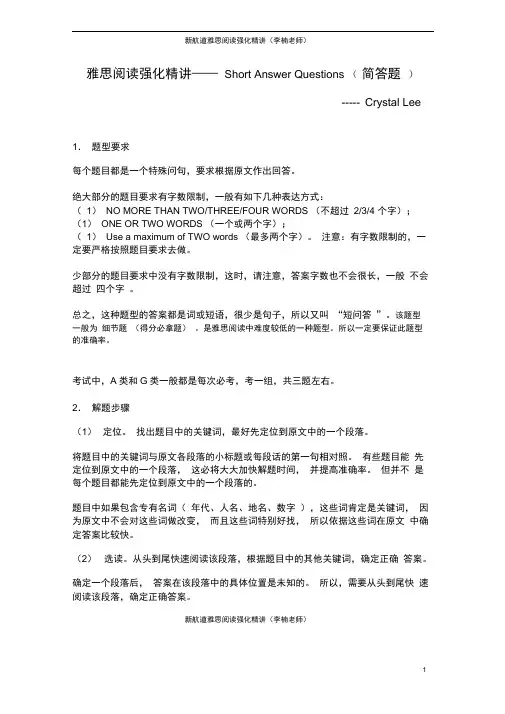
新航道雅思阅读强化精讲(李楠老师)雅思阅读强化精讲——Short Answer Questions (简答题)----- Crystal Lee1.题型要求每个题目都是一个特殊问句,要求根据原文作出回答。
绝大部分的题目要求有字数限制,一般有如下几种表达方式:(1)NO MORE THAN TWO/THREE/FOUR WORDS (不超过2/3/4 个字);(1)ONE OR TWO WORDS (一个或两个字);(1)Use a maximum of TWO words (最多两个字)。
注意:有字数限制的,一定要严格按照题目要求去做。
少部分的题目要求中没有字数限制,这时,请注意,答案字数也不会很长,一般不会超过四个字。
总之,这种题型的答案都是词或短语,很少是句子,所以又叫“短问答”。
该题型一般为细节题(得分必拿题)。
是雅思阅读中难度较低的一种题型。
所以一定要保证此题型的准确率。
考试中,A类和G类一般都是每次必考,考一组,共三题左右。
2.解题步骤(1)定位。
找出题目中的关键词,最好先定位到原文中的一个段落。
将题目中的关键词与原文各段落的小标题或每段话的第一句相对照。
有些题目能先定位到原文中的一个段落,这必将大大加快解题时间,并提高准确率。
但并不是每个题目都能先定位到原文中的一个段落的。
题目中如果包含专有名词(年代、人名、地名、数字),这些词肯定是关键词,因为原文中不会对这些词做改变,而且这些词特别好找,所以依据这些词在原文中确定答案比较快。
(2)选读。
从头到尾快速阅读该段落,根据题目中的其他关键词,确定正确答案。
确定一个段落后,答案在该段落中的具体位置是未知的。
所以,需要从头到尾快速阅读该段落,确定正确答案。
新航道雅思阅读强化精讲(李楠老师)(3)作答。
答案要对应题目中的特殊疑问词。
答案必须要对应题目中的特殊疑问词。
绝大部分的答案是名词或名词短语,也有少部分是动词或形容词短语。
特殊疑问词:what ,who ,when, where 答案词性:名词(时间,地点,人或单位等)答案例子:8:00am, classroom, calcium deposit, Australian taxpayer 注意事项:不需要时间名词前面的介词及冠词,钟点后面要有am 或pm 。
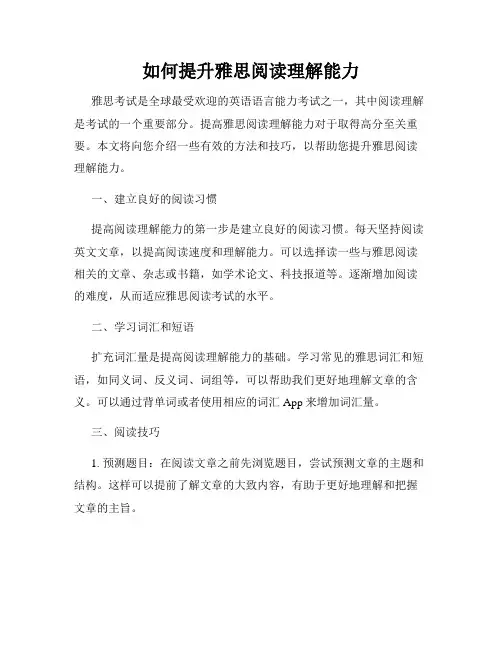
如何提升雅思阅读理解能力雅思考试是全球最受欢迎的英语语言能力考试之一,其中阅读理解是考试的一个重要部分。
提高雅思阅读理解能力对于取得高分至关重要。
本文将向您介绍一些有效的方法和技巧,以帮助您提升雅思阅读理解能力。
一、建立良好的阅读习惯提高阅读理解能力的第一步是建立良好的阅读习惯。
每天坚持阅读英文文章,以提高阅读速度和理解能力。
可以选择读一些与雅思阅读相关的文章、杂志或书籍,如学术论文、科技报道等。
逐渐增加阅读的难度,从而适应雅思阅读考试的水平。
二、学习词汇和短语扩充词汇量是提高阅读理解能力的基础。
学习常见的雅思词汇和短语,如同义词、反义词、词组等,可以帮助我们更好地理解文章的含义。
可以通过背单词或者使用相应的词汇App来增加词汇量。
三、阅读技巧1. 预测题目:在阅读文章之前先浏览题目,尝试预测文章的主题和结构。
这样可以提前了解文章的大致内容,有助于更好地理解和把握文章的主旨。
2. 找关键信息:在阅读过程中,要善于寻找关键信息,如人物、地点、时间、具体数据等。
这些关键信息有助于我们更好地理解文章并回答相关问题。
3. 掌握选项技巧:在解答选择题时,可以先扫描文章,找到与选项相关的段落或句子,然后再仔细阅读,找到正确答案。
遇到含有否定词的选项时要特别小心,因为这类选项往往容易误导。
四、多做练习做大量的阅读练习对于提高阅读理解能力非常重要。
可以使用雅思阅读模拟试题,模拟真实考试的环境和要求。
做题过程中要注意时间控制,锻炼自己在有限时间内提取关键信息和解答问题的能力。
五、阅读广泛的材料除了雅思相关的练习题,还可以阅读不同领域的文章,以增加对各种话题的理解。
可以选择一些英语杂志、报纸或者学术期刊,涉及生活、科技、文化等多个方面的内容,以提高阅读的广度和深度。
六、记笔记和总结阅读过程中可以在旁边或者纸上记下重点信息,可以帮助我们更好地理解文章并记忆。
阅读完一篇文章后,可以总结文章的主要观点、结构和论证方法等,这样有助于形成自己的思维导图和逻辑链条。
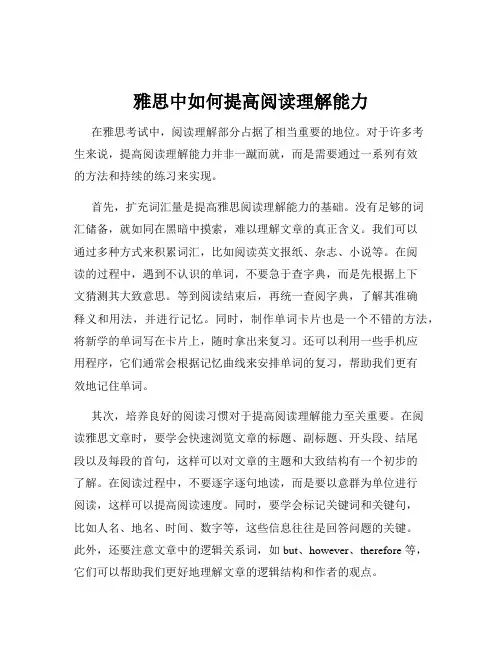
雅思中如何提高阅读理解能力在雅思考试中,阅读理解部分占据了相当重要的地位。
对于许多考生来说,提高阅读理解能力并非一蹴而就,而是需要通过一系列有效的方法和持续的练习来实现。
首先,扩充词汇量是提高雅思阅读理解能力的基础。
没有足够的词汇储备,就如同在黑暗中摸索,难以理解文章的真正含义。
我们可以通过多种方式来积累词汇,比如阅读英文报纸、杂志、小说等。
在阅读的过程中,遇到不认识的单词,不要急于查字典,而是先根据上下文猜测其大致意思。
等到阅读结束后,再统一查阅字典,了解其准确释义和用法,并进行记忆。
同时,制作单词卡片也是一个不错的方法,将新学的单词写在卡片上,随时拿出来复习。
还可以利用一些手机应用程序,它们通常会根据记忆曲线来安排单词的复习,帮助我们更有效地记住单词。
其次,培养良好的阅读习惯对于提高阅读理解能力至关重要。
在阅读雅思文章时,要学会快速浏览文章的标题、副标题、开头段、结尾段以及每段的首句,这样可以对文章的主题和大致结构有一个初步的了解。
在阅读过程中,不要逐字逐句地读,而是要以意群为单位进行阅读,这样可以提高阅读速度。
同时,要学会标记关键词和关键句,比如人名、地名、时间、数字等,这些信息往往是回答问题的关键。
此外,还要注意文章中的逻辑关系词,如 but、however、therefore 等,它们可以帮助我们更好地理解文章的逻辑结构和作者的观点。
掌握阅读技巧也是提高雅思阅读理解能力的关键。
例如,学会略读和扫读。
略读是快速阅读文章,获取文章的主旨大意;扫读则是有针对性地寻找特定的信息。
在做雅思阅读理解题目时,要先仔细阅读题目,明确题目要求,然后带着问题去文章中寻找答案。
对于判断题和选择题,要特别注意题干中的关键词,然后在文章中找到对应的内容进行比较和判断。
对于填空题,要分析空格前后的词汇和语法结构,预测可能填入的单词或短语。
另外,学会推理和猜测也是很重要的。
有些问题的答案可能并没有直接在文章中给出,需要我们根据文章中的相关信息进行推理和猜测。

雅思阅读强化讲义Table of ContentsReading Overview (1)1. Duration and Format (1)2. Ability tested (1)3. Question Types (1)Tough Nuts (2)1. Vocabulary (2)2. Complex Sentence (5)3. Reading Speed (6)Basic reading skills (briefly) (7)Solutions (9)1. List of Heading 标题对应 (9)2. Summary 总结归纳类 (14)3. TRUE/FALSE/NOT GIVEN (YES/NO/NOT GIVEN)题型 (18)4. Matching 匹配题 (23)5. Multiple Choice 选择题 (24)6. Short Answer Questions 简答题 (28)7. Diagrams 图表题 (30)Appendix 1 Word Root (38)Chapter 1 Reading Overview1. Duration and Format3 passages 40 questions 60 minutes 2500 words 8000 vocabularyAcademic Reading 1000 words2. Ability testedRead effectively - Sort out a summaryStructure Skimming Scanning Complex sentence3. Question Types1 Matching题型从属关系搭配或对应2 Summary题型摘要填空3 Short answer questions题型简答题4 Ture/False/Not Given题型是非题6 Headings题型找小标题7 Multiple choice题型选择题8 Sentence completion题型完成句子9 Diagram/flowchart/table completion题型填表填图10 其他题型直接填空、多选多+排序、全文主旨Chapter 2 Tough Nuts1.Vocabulary► Word root:1.ab -,ac-,ad-,af-,ag-,an-,ap-,ar-,as-,at-等加在同辅音字母的词根前,表示"一再"等加强意2.ex - 向外、加强3.im / in - 不、向内4.per - 贯穿、每一个5.pur - 向前6.pos - 位置7.de - 否定、除掉8.inter - 相互9.don - 两个都 - 几个11.cede - 走12.audi - 听13.dict - 说14.pre - 提前15.fact - 手、制作16.gress - 行走17.cede/ cess - 走18.loq - 说19.mob/mot/mov - 动20.rect - 直21.stract - 拉22.spec / spic - 看23.volv - 旋转24.vid/vis - 看、视觉的25.suc - 下面26.sub - 下面27.re - 重复、反28.un - 反29.mis - 反30.under - 下31.anti - 反32.Contra / counter 反33.Dia - 穿过34.Trans - 穿过、转移、改变See appendix 1► Thesaurus1. 解决:Solve, deal with, cope with, handle, resolve, address, tackle2. 损害: Damage, hurt, injure, harm, impair, undermine, jeopardize3. 给与:Give, offer, render, impart, provide, supply, afford4. 培养:Develop, cultivate, foster5. 优势:Advantage, merit, virtue, benefit, upside, strength6. 缺陷:Disadvantage, demerit, drawback, downside, weakness7. 使迷惑:Puzzle, bewilder, perplex, baffle8. 重要的:Key, crucial, critical, important, significant, vital, substantial, indispensable, imperative9. 认为:Think, believe, insist, maintain, assert, conclude, deem, hold, argue, be convinced10.保护:Protect, conserve, preserve11.确保:Assure, ensure, guarantee, pledge12. 有害的:Bad, baneful evil, harmful, detrimental13. 要求:Request, demand, needs, requisition14. 消除:Eliminate, clear, remove, clear up, take away, smooth away15. 导致: Lead to, bring about, result in, cause, spark off, conduce to, procure, induce, generate16. 因此:So, therefore, thus, hence, consequently, as a consequence, accordingly, as a result,17. 增长至:Grow to,rise to,increase to,go up to,climb to,ascend to,jump to,shoot to18.降低至:Dip to, fall to, decline to, decrease to, drop to, go down to, reduce to, slump to, descend to, sink to, slide to19.保持稳定:Level out, do not change, remain stable, remain still, remain steady, be stable,maintain the same level, remain unchanged, be still, remain the same level, stay constant, keep at the same level, level off, stabilize, keep its stability, even out20.急剧地:Dramatically, drastically, sharply, hugely, enormously, steeply, substantially, considerably,significantly ,markedly, surprisingly, strikingly, radically, remarkably, vastly, noticeably21. 平稳地:Steadily,smoothly,slightly,slowly,marginally,gradually,moderately,mildly22 . 宣称:Allege, assert, declare, claim23. 发生:Happen, occur, take place24. 原因:Reason, factor, cause25. 发展:Development, advance, progress26 . 有益的:Useful, helpful, beneficial, profitable, rewarding, advantageous27 . 影响:Influence, impact, effect28. 明显的:Clear, obvious, evident, self-evident, manifest, apparent, crystal-clear29. 占:Comprise, take up, account for, constitute, consist of, make up, occupy, hold, compose30. 与…相比:Compared with, compared to, in comparison with, in comparison to, by comparison with, by comparison to31. 对比而言:By contrast, in contrast, on the other hand, on the contrary=conversely32. 展示:Show, reveal, illustrate, demonstrate, depict, present, represent, describe33. 大约:Approximately, almost, about, around, nearly, roughly34. 波动:Fluctuate, go ups and downs, display a fluctuation, demonstrate a fluctuation35. 事实上:Practically, in practice, essentially, in essence, in reality, in effect, in fact, as a matter of fact, it is a fact that36. 换言之:Namely, that is to say, in other words, to put it like this, to put it differently, to put it from another way, to put it from another angleAcademic wordsplex Sentence例题1. The way people hold to the belief that a fun-filled, pain-free life equals happiness actually reduces their chances of ever attaining real happiness.1. This way actually reduces their chances of ever attaining real happiness.2. A fun-filled, pain-free life equals happiness.3. People hold to this belief.翻译:人们信奉的充实又无忧无虑的生活就等于幸福的信念实际上降低了他们获得真正的幸福的可能性。
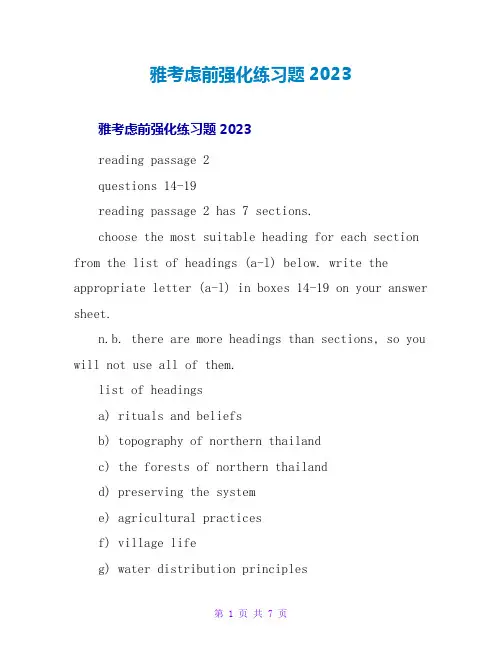
雅考虑前强化练习题2023雅考虑前强化练习题2023reading passage 2questions 14-19reading passage 2 has 7 sections.choose the most suitable heading for each section from the list of headings (a-l) below. write the appropriate letter (a-l) in boxes 14-19 on your answer sheet.n.b. there are more headings than sections, so you will not use all of them.list of headingsa) rituals and beliefsb) topography of northern thailandc) the forests of northern thailandd) preserving the systeme) agricultural practicesf) village lifeg) water distribution principlesh) maintaining natural balancesi) structure of the irrigation systemj) user's rightsk) user's obligationsl) munity control14. section 115. section 216. section 317. section 4answerexle section 5 a18. section 619. section 7the muang faai irrigation system of northern thailandsection 1northern thailand consists mainly of long mountain chains interspersed with valley bottoms where streams and rice fields dominate the landscape. most of the remaining forests of the north are found at higher altitudes. the forests ensure regular seasonalrainfall for the whole area and at the same time moderate runoff, so that there is water throughout the year.section 2the lowland munities have developed anagricultural system adapted to, and partially determining, the distinctive ecosystems of their areas. practicing wet-rice agriculture in the valley-bottoms, the lowlanders also raise pigs, ducks and chickens and cultivate vegetable gardens in their villages further up the slopes. rice, beans, corn and native vegetables are planted in hill fields above the villages, andwild vegetables and herbal medicines are gathered and wild game hunted in the forests higher up the hillsides. the forests also serve as grazing groundsfor cows and buffalo, and are a source of wood for household utensils, cooking fuel, construction and farming tools. fish are to be found in the streams and in the irrigation system and wet-rice fields,providing both food and pest control.section 3in its essentials, a muang faai system consists of a small reservoir which feeds an intricate, branching work of small channels carrying water in carefully calibrated quantities through clusters of rice terraces in valley bottoms. the system taps into a stream above the highest rice field and, when there is sufficient water, discharges back into the same stream at a point below the bottom field. the water in the reservoir at the top, which is diverted into a main channel (iam muang) and from there into the different fields, is slowed or held back not by an impervious dam, but by a series of barriers constructed of bunches of bamboo or saplings which allow silt, soil and sand to pass through.section 4water from the iam muang is measured out among the farmers according to the extent of their rice fields and the amount of water available from the main channel. also considered are the height of the fields, their distance from the main channel and their soil type. the size and depth of side-channels are thenadjusted so that only the allocated amount of water flows into each farmer's field.section 5section 6keeping a muang faai system going demands cooperation and collective management, sometimeswithin a single village, sometimes across three or four different subdistricts including many villages. the rules or mon agreements arrived at during the yearly meeting amount to a social contract. they govern how water is to be distributed, how flow is to be controlled according to seasonal schedules, how barriers are to be maintained and channels dredged, how conflicts over water use are to be settled, and how the forest around the reservoir is to be preserved as a guarantee of a steady water supply and a source of materials to repair the system.section 7questions 20-23the chart below illustrates the agricultural system of the lowland munities.select words from reading passage 2 to fill the spaces in the chart. use up to three words for each space. write your answers in boxes 20-23 on your answer sheet.area activityexleforestsgrazing cows, buffaloforestshill fieldsvillagesvalley bottom gathering ...... (20) ......, hunting wild animalscultivating ...... (21) ......raising ...... (22) ...... cultivating vegetables growing ...... (23) ......question 24from the list below, select the three main structures which constitute the muang faai irrigation system. write the three appropriate letters, in any order, in box 24 on your answer sheet.a) channelsb) saplingsc) damd) barrierse) reservoirf) waterquestion 25from the list below, select two criteria for allocating water to farmers. write two appropriate letters, in any order, in box 25 on your answer sheet.a) field characteristicsb) social statusc) location of fieldd) height of barrierse) fees paidf) water available。
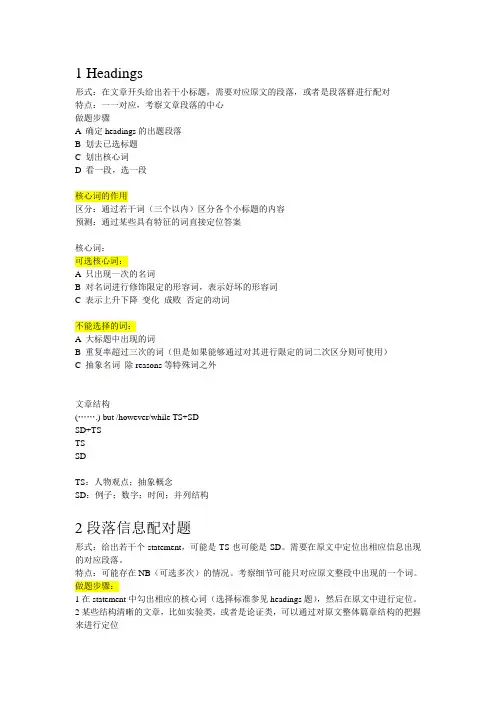
1 Headings形式:在文章开头给出若干小标题,需要对应原文的段落,或者是段落群进行配对特点:一一对应,考察文章段落的中心做题步骤A确定headings的出题段落B 划去已选标题C 划出核心词D 看一段,选一段核心词的作用区分:通过若干词(三个以内)区分各个小标题的内容预测:通过某些具有特征的词直接定位答案核心词:可选核心词:A只出现一次的名词B 对名词进行修饰限定的形容词,表示好坏的形容词C 表示上升下降变化成败否定的动词不能选择的词:A大标题中出现的词B 重复率超过三次的词(但是如果能够通过对其进行限定的词二次区分则可使用)C 抽象名词除reasons等特殊词之外文章结构(…….) but /however/while TS+SDSD+TSTSSDTS:人物观点;抽象概念SD:例子;数字;时间;并列结构2段落信息配对题形式:给出若干个statement,可能是TS也可能是SD。
需要在原文中定位出相应信息出现的对应段落。
特点:可能存在NB(可选多次)的情况。
考察细节可能只对应原文整段中出现的一个词。
做题步骤:1在statement中勾出相应的核心词(选择标准参见headings题),然后在原文中进行定位。
2某些结构清晰的文章,比如实验类,或者是论证类,可以通过对原文整体篇章结构的把握来进行定位具体常用定位词•某些具有特殊性质的词•a时间early centuries first recent•b数字statistics figures data (纯数字经常在配对题中作为定位词使用)•c金钱financial economic cost•d否定动词avoid deny stop limit remain stay fail•e上升下降raise improved(improvement) increase grow•downward (trend)• f 比较级,最高级(特殊比如preference)••negative positive benefit advantage success efforts(努力,一般是好的正面的)failure flaw drawback threat harm danger problem difficulty alarm argument(s) •上意词和下意词•Military:weapons,battlefield,arms,war•Animal:bats,beast,dolphin,whale•Wildlife:dolphin,whale,polar bear•Environment:air water soil land•Food supplement••不作为核心词出现的词•instructions•抽象N concerns research analysis•an example an exercise段落信息配对题的内容可能考察TS,这个时候题目就等于小标题对应题的变形(给出确定的小标题,要求找到对应的段落)。
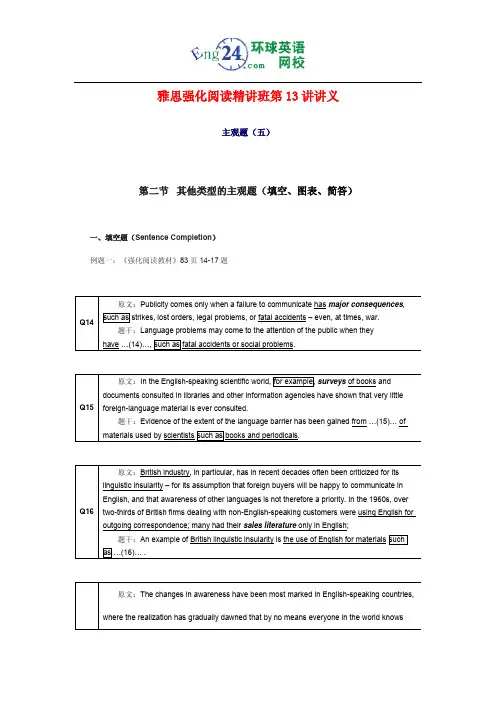
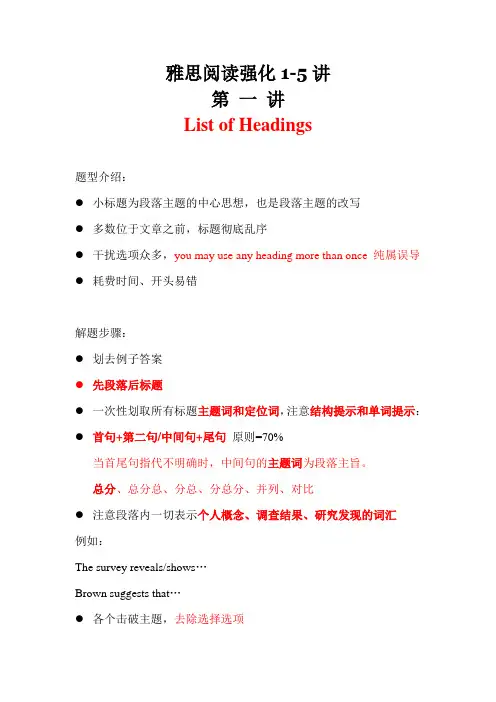
雅思阅读强化1-5讲第一讲List of Headings题型介绍:●小标题为段落主题的中心思想,也是段落主题的改写●多数位于文章之前,标题彻底乱序●干扰选项众多,you may use any heading more than once 纯属误导●耗费时间、开头易错解题步骤:●划去例子答案●先段落后标题●一次性划取所有标题主题词和定位词,注意结构提示和单词提示:●首句+第二句/中间句+尾句原则=70%当首尾句指代不明确时,中间句的主题词为段落主旨。
总分、总分总、分总、分总分、并列、对比●注意段落内一切表示个人概念、调查结果、研究发现的词汇例如:The survey reveals/shows…Brown suggests that…●各个击破主题,去除选择选项关于找主题的其它方法:●注意段落开头部分but/however/though/while/despite/despite thefact that…●开头部分有show, suggest, indicate, manifest段落中有 A show that BA showing that BA suggest that B●Apart from…/ besides/ not only…but also/ regardless of/otherthan/rather than●段落第一句如果是问句,则第二句是主题句●如果段落中有举例子,例子前面是主题句●重点单词的提示:反复出现的单词(原词同义词重复、指代重复)、●或者提炼首尾中句核心词汇,与选项对应。
●与符号有关的单词(括号、引号)、黑体字、斜体字P 17,P 31, P61,P 93, P115, P128 , p135, p163, p170 陈述首句含主旨有实有虚需辨析含义不明确、疑问句尾句总结申大意中间行文露踪迹例子、转折词、高频词单词结构相呼应同义近义词、短语、介词结果发现笔莫停show/manifest/indicate/suggest 转折举例必划定however, while, yet/for example句群划割意分明总、分、总、并列、对比雅思阅读强化第二讲---重点题型复习T/F/NG Summary阅读题型之判断题True/False/Not GivenYes/No/Not Given●题型本身的不严密,导致很多同学无法区分错和未提及,但是要正确对待TURE/FALSE/NOT GIVEN 的定义。
雅思阅读强化技巧有什么同学们光懂得埋头苦读是没用的,学习过程中还是需要有自己独特的一套方法,当然适合自己是最重要的。
然而,南京雅思培训班强调,不同的文章不同的问题需用不同的技巧。
同学们要知道雅思阅读强化技巧有什么?希望大家不要盲目的去学习,别人的方法在自己身上未必适用。
雅思阅读强化技巧有什么?1.不要先阅读文章内容在未清楚目的的时候看文章内容是很浪费时间的。
阅读测验分为3部分,很多考生都会用同一个方法处理每一部分,就是先详细看文章内容或快速扫描内容,在对文章有一定了解后才开始看问题。
这么做,到最后时间往往会不够用。
因为在他们阅读文章的时候,不知道需要注意什么内容和找什么答案。
雅思阅读强化技巧有什么?2.了解每段大意最快找到答案的方法是知道在哪个段落可以找到答案。
如已清楚每一段的内容大意,能够一接触问题时便知道哪一段最有可能包含答案。
要用最短的时间了解每个段落的大意,可采用以下方法:先看每个段落的第一句,然后看第二句,再看段落的最后一句。
如果还是不清楚这一段意思的话,便需要通篇都看。
雅思阅读强化技巧有什么?3.有顺序地阅读1)先看标题——看罢标题,对全篇文章应有一个大致的了解;2)看段落题目——知道每段的大概内容,从中推断文章的内容;3)看较深色或额外涂黑的字——这也可帮助了解文章内容;4)看图片——有时候看图片比看整段文字更有用。
先看图片、图表等等都利于了解内容;5)看指引——如不看指引,可能就不知道应以何种方式回答问题。
有时候指引也会包含一些关于文章的资料;6)看例句——例句不但可使考生了解如何正确回答问题,也可用一两句话使考生对文章有一个大概的了解,看例句绝不浪费时间;7)看问题——了解阅读文章时应留意什么。
雅思阅读强化技巧有什么?4.清楚文章和问题的方式和分布阅读测验的问题有时放在文章前有时在其后。
南京雅思需要考生必须清楚:阅读测验的3个部分在哪里开始,哪里完结;每部分有多少问题,哪里开始,哪里完结;应如何分配每部分的时间;应先回答哪些问题。
雅思阅读理解强化练习题在雅思备考中,考生一定要注意多对练习题进行练习,提高自己的阅读理解能力,争取在考试上考取满意的分数。
下面,小编就为大家送上一篇雅思阅读理解强化练习题,希望对大家有所帮助。
Hackers target the home front1. One of the UK's leading banks has been forced to admit that organised hacking gangs have been targeting its executives. For the past year, Royal Bank of Scotland has been fighting systematic attempts to break into its computer systems from hackers who have sent personalised emails containing keyloggers to its senior management. This has included executives up to board level and is now the subject of a separate investigation by the Serious and Organised Crime Agency.2. The hackers are homing in on the trend for people to work from home. The hackers make the assumption that the computers being used outside the work environment are more vulnerable than those protectedby a corporate IT department.Growing threat3. For companies it is a growing threat as home working increases: a recent survey from the Equal Opportunities Commission found that more than 60% of the UK's population wants the option of flexible working.4. And the hackers are employing increasingly sophisticated techniques. Each email they send is meticulously built to make it attractive to its target, who the criminals have carefully researched by trawling the internet for information. Once the email is composed, the malware is just as carefully designed: it is often modified to avoid detection by security software.5. The keylogger contained in the email installs itself automatically and then collects details of logins and passwords from the unsuspectinguser. This means that hackers can, using the usernames and passwords stolen by the keyloggers, connect to VPNs, or Virtual Private Networks, which many companies use to create an encrypted pathway into their networks.6. Once inside a bank's network, the hackers can communicate directly with computers holding account information and manipulate funds.7. Has this actually happened? In some cases sources claim that the login details of VPNs have been obtained and used though there has been no confirmation that any losses have occurred as a result. The attacks are not believed to have focused on RBS but to have been across the whole of the banking industry.8. Royal Bank of Scotland said that the bank had suffered no losses as a result of the attacks and added: RBS has extremely robust processes in place in order to protect our systems from fraud. Trojan email attacks are an industry-wide issue and are not isolated to a particular area or aparticular bank.9. It is not just banks that have been targets. Last year attempts were made to steal information from the Houses of Parliament using malicious email. Messagelabs, the company responsible for monitoring much of the email traffic of the government and big business for suspect software, said at the beginning of the year that criminals have been evolving more sophisticated techniques to attack corporate networks.10. According to Mark Sunner, chief technology officer of Messagelabs, the number of malicious emails targeted at individuals has been increasing. Two years ago they were being seen once every two months, but now they are seeing one or two a day. This has been accompanied by an increase in quality in the creation of Trojans and spyware.11. The hackers are now aiming to take over computers, particularly those of home users. Some of the malicious software that we are routinely seeing for that purpose will have its own antivirus system built into it sothat they can kill off the programs of their competitors.Increased vigilance12. Tony Neate, the head of Get Safe Online, a government-funded organisation set up to raise awareness among UK businesses of computer criminals, says: There is now an attempt to target individuals within UK businesses - including the banking sector. What is happening is that crime is doing what it always does, which is look for the weakest link. Home working is where they perceive a weakness.13. This points to a need for increased vigilance and security by those working from home and by those responsible for letting them work from home. For home working to be effective, security needs to be as effective as if working in an office.(667 words)Questions 1-4 Answer the questions below using NO MORE THAN THREE WORDS from the passage for each answer.1. What do the hackers use to attack the computer system of the Royal Bank of Scotland?2. Which word is most likely to be used by hackers to describe home computers?3. What do the majority of people in the UK prefer?4. How do hackers collect information so as to compose emails?5. What do hackers obtain illegally to gain access to banks’ computer network?Questions 5-12 Complete the sentences below with words from the passage.Use NO MORE THAN THREE WORDS for each answer.6. The use of login details of VPNs by criminals does not necessarily result in any ______________.7. Royal Bank of Scotland claimed that they are not the only victim of ______________.8. Corporate networks will be another target of hackers with improved _______________.9. The attacks on individuals have been greatly increased within _______________.10. With ________________, software used by criminals can eliminate its competing programs.11. Home users are chosen as a target because they are considered asa __________ .12. Get Safe Online is calling for an increase in _____________ to ensure safe home working.。
雅思阅读理解强化练习题(2)2017雅思阅读理解强化练习题Questions 6-13 Answer the following questions or complete the following sentences by choosing NO MORE THAN THREE WORDS for each answer.6.What is ING Direct and Vanguard?7.What might online banking customers be cheated to give at a fraudulent Web site?8.What may stop online banking customers from using new verification methods?9.The key to online banking security is to verify the ______ of customers.10.Where is PassMark Security located?11.What is the reason why SiteKey is popular among online banking customers?12.What was used instead of images in the Harvard and M.I.T. study?13.How many security methods are mentioned in this passage?Answer keys1. 第一段"Now a study suggests that a popular secondary security measure provides little additional protection."似与问题文字很接近,但是原文中a popular secondary security measure是指特定的`一个措施,而非泛指所有secondary security measure。